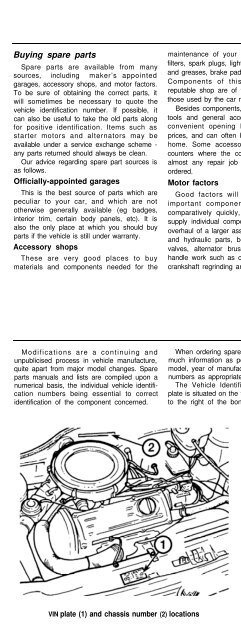Contents - Volkspage
Contents - Volkspage
Contents - Volkspage
You also want an ePaper? Increase the reach of your titles
YUMPU automatically turns print PDFs into web optimized ePapers that Google loves.
Buying spare parts REF.3<br />
Buying spare parts<br />
Spare parts are available from many<br />
sources, including maker’s appointed<br />
garages, accessory shops, and motor factors.<br />
To be sure of obtaining the correct parts, it<br />
will sometimes be necessary to quote the<br />
vehicle identification number. If possible, it<br />
can also be useful to take the old parts along<br />
for positive identification. Items such as<br />
starter motors and alternators may be<br />
available under a service exchange scheme -<br />
any parts returned should always be clean.<br />
Our advice regarding spare part sources is<br />
as follows.<br />
Officially-appointed garages<br />
This is the best source of parts which are<br />
peculiar to your car, and which are not<br />
otherwise generally available (eg badges,<br />
interior trim, certain body panels, etc). It is<br />
also the only place at which you should buy<br />
parts if the vehicle is still under warranty.<br />
Accessory shops<br />
These are very good places to buy<br />
materials and components needed for the<br />
maintenance of your car (oil, air and fuel<br />
filters, spark plugs, light bulbs, drivebelts, oils<br />
and greases, brake pads, touch-up paint, etc).<br />
Components of this nature sold by a<br />
reputable shop are of the same standard as<br />
those used by the car manufacturer.<br />
Besides components, these shops also sell<br />
tools and general accessories, usually have<br />
convenient opening hours, charge lower<br />
prices, and can often be found not far from<br />
home. Some accessory shops have parts<br />
counters where the components needed for<br />
almost any repair job can be purchased or<br />
ordered.<br />
Motor factors<br />
Good factors will stock all the more<br />
important components which wear out<br />
comparatively quickly, and can sometimes<br />
supply individual components needed for the<br />
overhaul of a larger assembly (eg brake seals<br />
and hydraulic parts, bearing shells, pistons,<br />
valves, alternator brushes). They may also<br />
handle work such as cylinder block reboring,<br />
crankshaft regrinding and balancing, etc.<br />
Tyre and exhaust specialists<br />
These outlets may be independent, or<br />
members of a local or national chain. They<br />
frequently offer competitive prices when<br />
compared with a main dealer or local garage,<br />
but it will pay to obtain several quotes before<br />
making a decision. When researching prices,<br />
also ask what “extras” may be added - for<br />
instance, fitting a new valve and balancing the<br />
wheel are both commonly charged on top of<br />
the price of a new tyre.<br />
Other sources<br />
Beware of parts or materials obtained from<br />
market stalls, car boot sales or similar outlets.<br />
Such items are not invariably sub-standard,<br />
but there is little chance of compensation if<br />
they do prove unsatisfactory. In the case of<br />
safety-critical components such as brake<br />
pads, there is the risk not only of financial loss<br />
but also of an accident causing injury or death.<br />
Second-hand components or assemblies<br />
obtained from a car breaker can be a good<br />
buy in some circumstances, but this sort of<br />
purchase is best made by the experienced<br />
DIY mechanic.<br />
Vehicle identification<br />
Modifications are a continuing and When ordering spare parts, always give as number is stamped below the lip of the engine<br />
unpublicised process in vehicle manufacture, much information as possible. Quote the car bay bulkhead. (see illustration).<br />
quite apart from major model changes. Spare model, year of manufacture, body and engine The engine number is stamped on the<br />
parts manuals and lists are compiled upon a numbers as appropriate. cylinder block, below the ignition distributor<br />
numerical basis, the individual vehicle identifi- The Vehicle Identification Number (VIN) flange (see illustration). In addition, a bar<br />
cation numbers being essential to correct plate is situated on the front engine bay panel, code label attached to the timing belt cover<br />
identification of the component concerned. to the right of the bonnet lock. The chassis contains engine code information.<br />
VIN plate (1) and chassis number (2) locations<br />
Engine number and engine code locations (arrowed)

















